Sara Strådal
United Kingdom
Diagrams are prevalent in many different types of medieval manuscripts; they are used to illustrate theological and moral concerns as well as scientific and medical theories. In religious manuscripts they have often been investigated and understood in terms of their mnemonic functions. For example, Lucy Freeman Sandler describes how diagrams in the De Lisle Psalter is supposed to guide the reader through understanding of key Christian virtues,1 and Mary Carruthers has written extensively on the use of diagrams as a memory aid in medieval religious practice and as a tool in devotional as well as scholarly activities.2
Christian diagrams have typically been examined in terms of the multiple functions and religious meanings that they carried and communicated, while scientific and medical diagrams are often placed in a different category, considered almost entirely for the theoretical or practical ideas that they render. This essay will show that diagrams included in late medieval medical contexts, like their theological counterparts, often had multiple functions and divergent meanings. They had practical medical functions, but they also had other purposes that were specific to their different audiences. To illustrate how the choice of diagrams reflected social ambition and the practical needs of the medical practitioners and patrons commissioning and using these works, this essay will compare the use of diagrams in three late medieval surgical manuscripts by John of Arderne with two folding almanacs.3 All five of the these works are written in Latin and decorated with illustrations and diagrams. The surgical manuscripts contain illustrations of treatments and concepts discussed in the text; the folding almanacs contain medical diagrams and illustrations of solar and lunar eclipses. Representing different points on the artistic spectrum, the Harley folding almanac contains largely the same texts and images as the Crawford almanac, but the illustrations are elaborate and contain more color. Similarly, Hunter 251 and Hunter 112 both contain more elaborate and multicolored illustrations than Hunter 339, illustrated with line drawings sometimes highlighted in red.
John of Arderne, a fourteenth-century English surgeon who lived and practiced in Newark and London, was best known for his innovative treatment of anal fistula (fistula-in-ano).4 Arderne’s new treatment combined two older procedures, involving cutting the fistula open, keeping the wound clean, washing it with oils and changing the dressing every few days.5 He boasts of a tremendous 50% survival rate where it had previously been nil. He wrote several texts but the most influential and widely disseminated one is his Practice of Surgery, which includes his treatment of fistula-in-ano.6 There are over fifty of these manuscripts extant today, and thirty-six of them have a full image cycle including some 250 marginal and larger illustrations. All three manuscripts discussed here belong in this latter category.8 The illustrations include depictions of different stages of the procedure, surgical tools, herbs, body parts and diagrams fundamental to medical practices, such as the Zodiac Man (Homo Signorum) (Fig. 1).9 The Zodiac Man is an anthropomorphic diagram showing what astrological sign affected or controlled which part of the body. Besides indicating at what periods of the astrological cycle surgery on a given part of the body could be successfully performed, this diagram was an economical way to visually describe the interrelationship of the macrocosm of the universe and the microcosm of the individual human body.10 This theory of the relationship between the environment and the health of the individual was an ancient idea that lived on in medieval medical thought.11 In Arderne’s treatise, the Zodiac Man diagram is surrounded by a text concerning blood-letting. In all three manuscripts examined here, it is accompanied by an astrological table used for calculating the position of the moon and auspicious times for blood-letting or other surgical treatments.
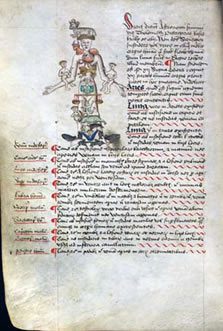 |
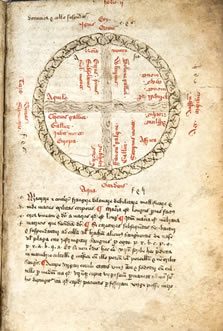 |
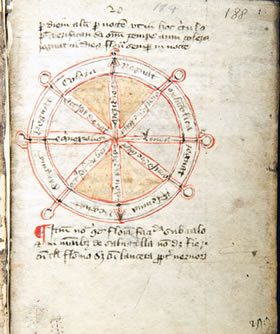 |
| Fig. 1 – Zodiac Man (Homo Signorum), By permission of University of Glasgow Library, Special Collections, Hunter 251, f. 49v |
Fig. 2 – Wind Diagram By permission of University of Glasgow Special Collections, Hunter 112, f. 3r |
Fig. 3 –Humoral Diagram By permission of University of Glasgow Special Collections, Hunter 339, f.118r |
The Arderne codices also contain other diagrams that bear no direct relation to the procedures described in their accompanying texts. One of those is the wind diagram that opens the book (Fig. 2). All three manuscripts include a version of this figure positioned at the beginning, and although they differ stylistically, they all contain the same information. They show the world divided into three continents with Asia at the top with Europe and Africa at the bottom. They also describe the interrelationship of the winds, the humors, the cardinal directions and beyond the earthly sphere, the influence of the stars. The text surrounding this diagram is the introduction to Arderne’s treatise, Mirror of Phlebotomy, a guide to blood-letting.
 |
| Fig. 4 – Folding Almanac Crawford Library of the Royal Observatory Edinburgh, Crawford 2.20(2) |
A further diagram relevant to this discussion concerns the four humors (Fig. 3). This figure has not been added in two of the manuscripts discussed here but spaces have been left to accommodate it. This diagram charts the influences of the different humors during certain parts of the day. Rendered to look like a wheel, each of the spokes represents a different part of the day and night, and the text positioned around the wheel explains which humor is most dominant during that period. The text discusses suitable times of the day for treatments, such as phlebotomy and its inclusion, or intended inclusion, is always towards the end of Practice of Surgery.
Both the wind and humoral diagrams function as visual representations of contemporary academic knowledge and they do so in a way that addresses contemporary concerns that were specific to the author and his aspirational academic milieu. Humoral theory as part of the complex interrelationship between the macrocosm and microcosm was inherited from Antiquity and remained a cornerstone of medieval medical theory.12 The wind diagram and the humoral diagram, as opposed to the other illustrations in the Arderne manuscripts, have no direct relationship to the procedure or treatment of fistula-in-ano. Rather, by including them the entire academic tradition, following on Galen and Hippocrates, is referenced and emphasized by aligning Arderne’s original text with authoritative academic and ancient sources.
To better understand these diagrams, it is useful to compare them to diagrams in folding almanacs, another medical source material used in a different context. The two discussed here, Harley and Crawford, are constructed out of individual sheets of parchment folded and sewn together to create a fan-like structure that allows each leaf to be unfolded individually (Fig. 4).13 In previous scholarship, the folding almanacs have been associated with doctors and referred to as physicians’ handbooks. For example, Peter Murray Jones speculates that the unfolding of an almanac could have been part of the ritual of the physician’s examination.14 In her study of the twenty-nine extant English folding almanacs, Hilary M. Carey indicates that many of them contain material useful in the practise of astrological medicine (iatromathematics).15 Although these objects have often been associated with medieval physicians and their trade, she argues that there is no evidence that the medical practitioners owning and using them were exclusively physicians and not, for example, barber-surgeons.16 Nevertheless, their high level of artistic execution suggests that some of them would certainly have been owned only by affluent medical practitioners. It is also possible that some were owned by lay patrons who had no training or professional medical responsibilities.17 Given their range of associations, the study of folding almanacs can offer valuable insights into the relationship between patient and medical practitioner as well as contemporary notions of astrological medicine and the individual’s placement within the universe.
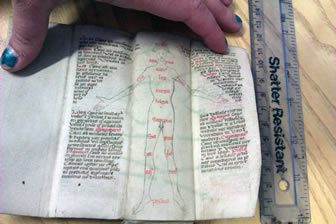 |
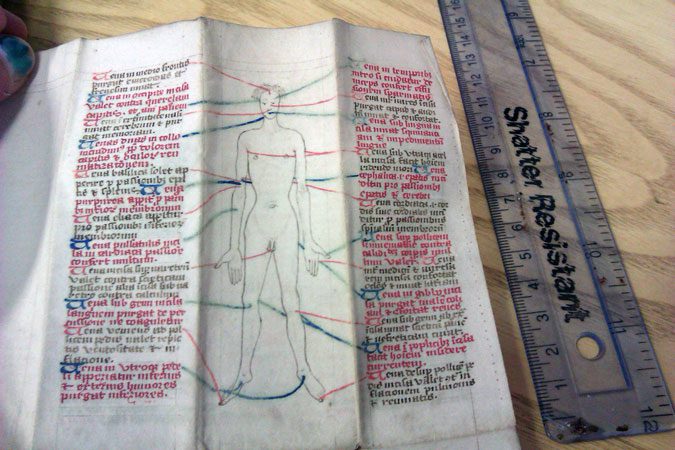 |
| Fig. 5 – Zodiac Man Crawford Library of the Royal Observatory Edinburgh, Crawford 2.20(2) |
Fig. 6 – Vein Man (Homo Venarum) Crawford Library of the Royal Observatory Edinburgh, Crawford 2.20(2) |
The Harley and Crawford almanacs are similar in appearance, structure, and contents. They both include calendars, illustrated solar and lunar eclipses and illustrations of the Zodiac Man and the Vein man (homo venarum). Harley also contains a Sphere of Life and Death18 and a volvelle, a movable wheel chart. The Crawford almanac opens with a calendar, followed by an astrological diagram, textual description and illustrations of solar and lunar eclipses and lastly, two anthropomorphic diagrams. A Zodiac Man is situated on the first fold and when further unfolding the parchment, a Vein Man, a standard medieval medical figure showing which veins to cut for effective blood-letting, is placed on the opposite side of the parchment (Figs. 5 and 6). Conversely, Harley contains a Vein Man on the first parchment sheet, followed by information about the movable feasts, a calendar, and on the fifth parchment, a Zodiac Man (Fig. 7 and 8). The text surrounding the image explains how it functions in relation to surgical practice:19 the moon was believed to make blood and the humors flow more freely, so the parts of the body ruled by specific signs were considered at a higher risk of injury and should not be cut or operated on during these periods.20
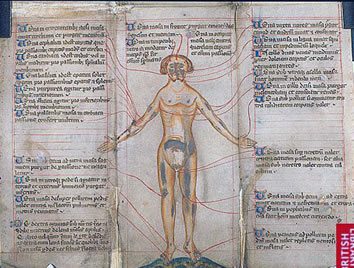 |
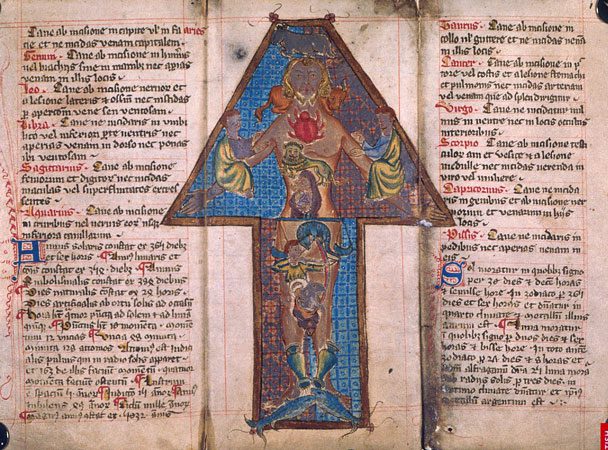 |
| Fig. 7 –Vein Man
© The British Library Board Harley MS 5311 |
Fig. 8 –Zodiac Man
© The British Library Board Harley MS 5311 |
The text accompanying the Zodiac Man and the Vein Man in both Harley and Crawford is arranged in two columns on either side of the respective figures. The section concerning Aries, the star sign associated with the head, is written on the left side of the figure while the text regarding Taurus, the star sign associated with the shoulders, is situated on the right side of the figure. The text-image relationship encourages the reader to read the text through the body of the human figure rather than as separate columns. A connection between the Zodiac Man and the Vein Man in both manuscripts is emphasized through the similar figural appearance and mise-en-page. This juxtaposition of the figures, the Zodiac Man showing the influence of the stars and the Vein Man illustrating how to treat internal humoral imbalances through phlebotomy situate the individual body firmly within the macrocosm of the universe and with their fifteenth-century hairstyles, in the here-and-now.
In Harley, the Zodiac Man is followed by illuminations of solar and lunar eclipses and on the ninth parchment, the reader-viewer encounters two different medical tools. The first one is the Sphere of Life and Death, here called the Sphere of Apuleius (Spera Appulei) (Fig. 9).21 The other pictorial motif linking the almanac with the practice of physicians are the jordans, urine glasses, rendered in the lower part of this image.22 The different colors of the urine depicted inside the jordans indicates different humoral imbalances within a body. It was believed that through close study of urine by examining appearance, smell, and even taste, a skilled physician could diagnose an illness, sometimes without even seeing the patient.23 After this parchment, the almanac concludes with an imperfect volvelle, a type of wheel chart used for calculating the positions of the moon.
The relationships revealed by these various diagrams, the effects of the stars on the human body as charted on the Zodiac Man, the use of phlebotomy as a way to manipulate the humoral balance within the body as marked on the Vein Man and the study of urine as a way to detect illnesses were conceivably explained to the patient by the surgeon or physician to justify their treatment decisions. All of the diagrams above describe the same humoral and astrological theories but they do so in different ways. So why are these particular diagrams chosen for inclusion in these texts?
I suggest that John of Arderne wrote his text and designed the pictorial cycle that accompanied it for several reasons: to advertise and explain his treatment but also to promote his social and authoritative status and that of his fellow surgeons. Arderne addresses his text to other master-surgeons, it is therefore important to understand their position in contemporary society. In England during this period, medical professionals were organized according to a strict hierarchy which accorded university educated doctors higher status than surgeons and barber surgeons who had been trained and licensed through the guilds. The relationship between the practices of medicine and surgery was seen as analogous to the relationship between geometry and carpentry: the first in each case was theoretical, while the second was more practical. Physicians who adjusted the humoral balance within the body did so in accordance with theoretical guidelines, while surgeons who bled and cut, dealt with wounds and cancers practised a form of medicine driven by more practical considerations.25
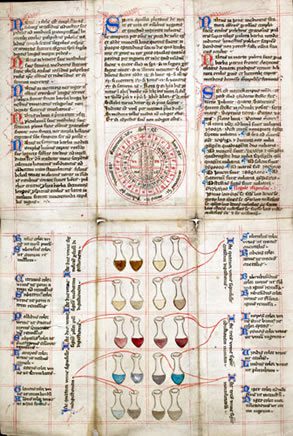 |
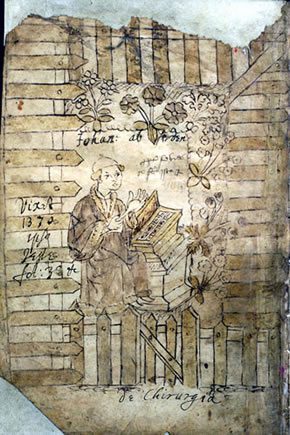 |
|
Fig. 9 – Sphere of Apuleius (Spera Appulei) and Jordans © The British Library Board Harley MS 5311 |
Fig. 10 –Author portrait
By permission of University of Glasgow Special Collections, Hunter 112, f. 1r |
John of Arderne was literate in Latin, he trained not at university but through a guild. He wrote his text against the backdrop of an ongoing conflict between the London Guild of Barbers and the Fellowship of Surgeons with regards to licensing and rights to training and practice.26 To emphasise his superior skill he recounts a story of how a barber treated a man with a wounded arm and almost killed him, but that how he, a surgeon, managed to save the patient’s life.27 Another response to this conflict is visible in the author portrait included in Hunter 112,28 where Arderne is shown wearing the long robes of a university educated physician (Fig. 10). A barber-surgeon would have worn shorter robes ending above the knee. This is one strictly visual way in which Arderne aligned himself and his profession with academically trained physicians. Another is the inclusion of the wind, humoral, and anthropomorphic diagrams, all emblems of the academic tradition.
Conversely, the folding almanacs might have been used in a different way. Writing about the interactions between medical practitioners and their patients and the need for practitioners to gain their patients’ trust, Michael McVaugh has noted that:
physicians had to shape their behavior toward patients in such a way as to keep reinforcing that authority and to maintain patient confidence, and the new Galenic literature allowed physicians to claim that this was not just a matter of self-interest, it was a medical necessity, an important part of therapy.30
If the hypothesis that the folding almanacs were a part of the ritual of seeing a medical practitioner, then perhaps, as suggested above, these diagrams were shown to the patient by the medical practitioner to support a diagnosis. The Zodiac Man and the Vein Man are more easily accessible than the wind and humoral diagrams discussed here, but they all describe the same theories, the effect of the universe on the humoral balance within the body of the individual. By emphasizing and explaining their mastery of humoral theory and astrological medicine with the aid of medical diagrams, practitioners using the folding almanacs could reaffirm their positions of authority before their patients.
The same knowledge and academic tradition is emphasized in the surgical texts, but in a way that also stresses scholastic and academic training. By beginning the treatise with an author portrait, followed by a wind diagram, John of Arderne chose to promote his own knowledge and training as equal to that of university educated physicians and as superior to barber-surgeons. The circulation of manuscript copies of his treatise provided him with a way to disseminate his own self promotional agenda. More broadly, in this essay I have shown that the choices made when rendering and selecting diagrams for inclusion in medieval medical manuscripts, beyond their practical or mnemonic functions, illustrate contemporary concerns with status and authority which were specific to users and their viewing audiences. I believe that this thesis can fruitfully be expanded through fuller investigations of the primary and auxiliary functions of scientific diagrams and their audiences, with equal attention paid to the texts, images, and the medical landscape a deeper understanding can be reached of the medieval scientific and medical community and its many complex theological, social, and academic concerns.
Notes
- Lucy Freeman Sandler, The Psalter of Robert de Lisle in the British Library (London: Harvey Miller, 1983), p. 82.
- Mary Carruthers, “Ars oblivionalis, ars inveniendi:The Cherub Figure and the Arts of Memory,” Gesta 48, (2009): 16
- Glasgow, University of Glasgow Special Collections, MSS Hunter 251, Hunter 339 and Hunter 112. Edinburgh, Edinburgh Royal Observatory, Crawford 2.20 (2); London, British Library, Harley 5311.
- Fistula-in-ano is a form of ulcerated abscess that was hard to treat and resulted in many fatalities.
- Nancy G. Siraisi, Medieval and Early Renaissance Medicine: An Introduction to Knowledge and Practice (Chicago: University of Chicago Press, 1990), pp.183-5.
- A middle-English version of this text has been printed by the Early English Text Society Treatises of fistula-in-ano, haemorrhoids and clysters ed. D. Power, EETS 139 (1910; reprint 1968).
- Peter Murray Jones, “Sicut hic depingitur… John of Arderne and English Medical Illustration in the 14th and 15th Centuries,” in Die Kunst und das Studium der Natur vom, 14 (1987): pp.107-108.
- Glasgow, University of Glasgow Special Collections, MSS Hunter 251 (U.4.9) (Specvlvm Phlebotomiae and Practica Chirvrgiae, produced between 1419-1550 in England) Hunter 112 (T.5.14) ( Specvlvm Phlebotomiae and Practica Chirvrgiae, produced between 1349-1450 in England), Hunter 339 (U.8.7) (Opera, produced between 1299-1399 in England). These items contain some 250 marginal and larger illustrations. These items have been discussed in L. MacKinney, Medical illustrations in medieval manuscripts (London, 1965); John Young & P.H. Aitken, A catalogue of the manuscripts in the Library of the Hunterian Museum in the University of Glasgow (Glasgow, 1908); Kathleen L. Scott, A Survey of Manuscripts Illuminated in the British Isles: Later Gothic Manuscripts [II] 1390-1490 (Murska Sobota, Slovenia:1996).
Hunter 251 and Hunter 112 are also discussed in Nigel Thorp, The glory of the page (London, 1987). - The Homo Signorum appears on f. 49v in Hunter 251, on f.47r in Hunter 112 and on f.123v in Hunter 339.
- Carole Rawcliffe, Medicine & Society in Later Medieval England (Phoenix Mill: Allan Sutton, 1995), pp. 82-3.
- Charles Clark, “The Zodiac Man in Medieval Astrology,” Journal of The Rocky Mountain Association 3 (1982): 15-16; Harry Bober, “The Zodiacal Miniature of the Très Riches Heures of the Duke of Berry: Its Sources and Meaning,” in Journal of the Warburg and Courtauld Institutes 11 (1948).
- Vivian Nutton, “Medicine in Medieval Western Europe, 1000-1500,” The Western Medical Tradition: 800 BC to AD 1800 (Cambridge: University Press Cambridge, 1995); Lawrence I. Conrad (et al) eds, p. 139-145.
It was primarily Latin translations of Greek and Arabic sources that influenced the study of medicine in this period, influential texts include Haly Abbas Pantegni (Universal art), Galen’s Tegni (Art of Healing) and Constantine the African’s commentary on the Hippocratic Aphorisms and Prognostics. - London, British Library, MSS Harley 5311 (This item contains a calendar, solar and lunar eclipses, Phlebotomy Man, Zodiac Man, illustration of urine glasses and Sphere of Life and Death. Produced c. 1406 in England). A Catalogue of the Harleian Manuscripts in the British Museum, 4 vols (London: Eyre and Strahan, 1808-12). Loren MacKinney and Thomas Herndon, Medical Illustrations in Medieval Manuscripts, Wellcome Historical Medical Library, New Series, 5 (London: Wellcome Historical Medical Library, 1965). Kathleen L. Scott, Later Gothic Manuscripts 1390-1490, A Survey of Manuscripts Illuminated in the British Isles, 6, 2 vols (London: Harvey Miller, 1996).Edinburgh, Royal Observatory, MSS Crawford 2.20 (2) (Calendar, solar and lunar eclipses, Vein Man and Zodiac Man. Produced c. 1461 in England). Catalogue of the Crawford library of the Royal observatory, Edinburgh. (1890).
- Peter Murray Jones, “Image, Word, and Medicine in the Middle Ages,” in Visualizing Medieval Medicine and Natural History , 1200-1500, ed. Jean A. Givens, Karen M. Reeds. and Alaine Touwaide, Alain, eds (Aldershot: Ashgate, 2006), p.11.
- Hilary M. Carey, “What is the Folded Almanac? The Form and Function of Key Manuscript Sources for Astro-Medical Practice in Later Medieval England,” Social History of Medicine 16 (2003): 481-2.
- Ibid. pp. 489-92.
- Hilary M. Carey, “Astrological Medicine and the Medieval English Folded Almanac,” Social History of Medicine 17 (2004): 359-63.
- The Sphere of Life and Death is a medical tool used for calculating the survival chances of the patient. They are commonly referred to as the Sphere of Pythagoras or Sphere of Apuleius.
- The text, from John Somer’s Kalendarium, explains when to avoid surgery or treatment of a particular body part. For example, the text concerning Aries reads Cave ab inscisione in capite vel in facie et ne inscindas venam capitalem [Beware of cutting in the head or n the face, and do not cut into the head vein] and the text concerning Taurus reads Cave ab inscisione in collo vel in gutture et ne inscindas venam in illis locis [Beware of cutting in the neck or n the throat, and do not cut into the vein n these places].
- Rawcliffe (1995): p.82.
- Linda Ehrsam Voigts, “The Latin verse and Middle English Prose Texts on the Sphere of Life and Death in Harley 3719,” Chaucer Review 21 (1986): p. 294-295.
- According to Carole Rawcliffe jordans got their name from the river in which Christ was baptised, a scene that would often be re-enacted by the barber’s guild in mystery plays. Rawcliffee (1995): Caption to color plate 7 after page 50.
- Ibid. pp. 46-52.
- Laurel Means, “’Ffor as moche as yche man may not haue Þe astrolabe’: Popular Middle English Variations on the Computus,” Speculum 67 (1992): 600-601. After this parchment, the almanac concludes with an imperfect volvelle, a type of wheel chart used for calculating the positions of the moon.
- Ibid. pp. 125-7.
- Ibid. p. 133. See also Richard T. Beck, The Cutting Edge: Early History of the Surgeons of London (London: Lund Humphries, 1974).
- John Arderne, Treatise of Fistula in Ano, Haemorrhoids and Clysters (London: Early English Text Society, 1910), p. 100.
- fol. 1r
- W. J. Bishop, “Notes on the History of Medical Costume,” Annals of Medical History 6 (1934) p. 196.
- Michael McVaugh, “Beside Manners in the Middle Ages,” Bulletin of the History of Medicine 71 (1997): 210.
References
- Arderne, John, Treatise of Fistula in Ano, Haemorrhoids and Clysters (London: Early English Text Society, 1910).
- Beck, Richard T., The Cutting Edge: Early History of the Surgeons of London (London: Lund Humphries, 1974) .
- Bishop, W. J. ”Notes on the History of Medical Costume,” Annals of Medical History 6 (1934):
193- 218. - Bober, Harry, “The Zodiacal Miniature of the Très Riches Heures of the Duke of Berry: Its Sources and Meaning,” in Journal of the Warburg and Courtauld Institutes 11 (1948): 1-34.
- Carey, Hilary M., “Astrological Medicine and the Medieval English Folded Almanac,” Social History of Medicine 17 (2004): 345-363.
- Carey, Hilary M., “What is the Folded Almanac? The Form and Function of Key Manuscript Sources for Astro-Medical Practice in Later Medieval England,” Social History of Medicine 16 (2003): 481-509.
- Carruthers, Mary, “Ars oblivionalis, ars inveniendi:The Cherub Figure and the Arts of Memory,” Gesta 48, (2009): 1-19.
- Clark, Charles, “The Zodiac Man in Medieval Astrology,” Journal of The Rocky Mountain Association 3 (1982): 13-38.
- Jones, Peter Murray, “Image, Word, and Medicine in the Middle Ages,” in Visualizing Medieval Medicine and Natural History, 1200-1500, ed. Jean A. Givens, Karen M. Reeds. and Alaine Touwaide, Alain, eds (Aldershot: Ashgate, 2006): 1-25.
- Jones, Peter Murray, “Sicut hic depingitur… John of Arderne and English Medical Illustration in the 14th and 15th Centuries,” in Die Kunst und das Studium der Natur vom 14. zum 16.Jahrhundert, 14 (1987): 103-26.
- McVaugh, Michael, “Beside Manners in the Middle Ages,” Bulletin of the History of Medicine 71 (1997): 201-223.
- Means, Laurel, “’Ffor as moche as yche man may not haue Þe astrolabe’: Popular Middle English Variations on the Computus” Speculum 67 (1992): 595 -623.
- Nutton, Vivian, “Medicine in Medieval Western Europe, 1000-1500,” The Western Medical Tradition: 800 BC to AD 1800 (Cambridge: University Press Cambridge, 1995); Lawrence I. Conrad (et al) eds.
- Rawcliffe, Carole, Medicine & Society in Later Medieval England (Phoenix Mill: Allan Sutton, 1995).
- Sandler, Lucy Freeman, The Psalter of Robert de Lisle in the British Library (London: Harvey Miller, 1983).
- Siraisi, Nancy G., Medieval and Early Renaissance Medicine: An Introduction to Knowledge and Practice (Chicago: University of Chicago Press, 1990).
- Voigts, Linda Ehrsam, “The Latin verse and Middle English Prose Texts on the Sphere of Life and Death in Harley 3719” Chaucer Review 21 (1986): 291-305.
SARA ÖBERG STRÅDAL, MA, MPhil, is a second year PhD student. She has previously received her undergraduate and MPhil degree in History of Art at the University of Glasgow. For her MPhil she studied the illustrations in three late medieval surgical manuscripts by John of Arderne and she expanded this project for her thesis. Her current PhD research focuses on diagrams in late medieval English medical manuscripts, where she considers their auxiliary functions beyond being mnemonic devices.
Highlighted in Frontispiece Summer 2013 – Volume 5, Issue 3
Summer 2013 | Sections | Antiquity

Leave a Reply